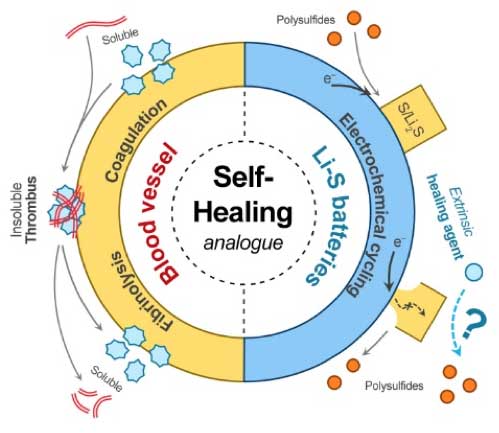| Posted: Apr 19, 2017 | |
A self-healing rechargeable battery with ultralong cycling life |
|
| (Nanowerk Spotlight) There is a growing demand for high-energy-density batteries in order to meet the requirements of electric vehicles, portable electronics and smart grid. | |
| Lithium metal anode with ultrahigh theoretical specific capacity (3860 mA h g-1) and the lowest negative electrochemical potential (-3.040 V vs. the standard hydrogen electrode), has been considered the most promising electrode for next-generation rechargeable batteries, including rechargeable Li-S, Li-air batteries, and even Li metal batteries which utilize intercalation compounds as cathodes. | |
| The earliest commercial products of rechargeable Li batteries can date from 1970s. However, metallic Li electrodes were quickly discarded due to Li dendrite growth. | |
| “During repeated Li plating/stripping cycles, the formation of Li dendrites will not only induce many ‘dead Li’ with capacity loss, but also have the potential to cause internal short circuit and even explosion of batteries. Therefore, gaining dendrite-free lithium metal anode is critical issues for promoting the practical applications of lithium metal batteries,” said Prof. Qiang Zhang, a faculty at Department of Chemical Engineering, Tsinghua University. | |
| “At the beginning of Li plating, the Li ions that reach the current-collector surface will acquire electrons and start nucleation. The nucleation sites for Li plating are isolated and randomly distributed if the matrix is not lithiophilic, which tends to induce a non-uniform Li deposition,” he continues. “A ‘lithiophilic’ matrix that has a strong binding energy between Li atoms and the surface of the matrix, which is preferred for Li metal nucleation with a reduced polarization.” | |
| Zhang and his team have published new findings on this topic in Angewandte Chemie ("Lithiophilic Sites in Doped Graphene Guide Uniform Lithium Nucleation for Dendrite-Free Lithium Metal Anodes") | |
 |
|
| Lithium metal anodes employing nitrogen doped graphene matrix with lithiophilic nucleation sites can guide uniform and densely distributed metallic Li nuclei, which is capable of leading to evenly platted lithium metal deposits. With the regulation on nucleation process, the dendrite-free lithium metal anodes exhibit impressive electrochemical performance. (Image: Tsinghua University) | |
| “Designing a Li plating matrix with a high surface area and lithiophilic surface maybe can help us gain dendrite-free metal anode,” said Rui Zhang, a graduate student at Department of Chemical Engineering, Tsinghua University. | |
| “Nitrogen-doped graphene (NG) is full of lithiophilic functional groups, such as pyridinic, pyrrolic, and quaternary nitrogen atoms, which was conducted based on density functional theory,” said Xiang Chen, another author of the paper. | |
| “Herein, we use NG as Li plating matrix, which possesses densely and uniformly distributed lithiophilic functional groups designed,” said Xiao-Ru Chen, a undergraduate at Tsinghua University. “The designed matrix can regulate Li nucleation sized and sites, therefore, we gain dendrite-free metal anode successfully.” | |
| Dendrite-free Li metal deposits make the NG electrodes exhibit an impressive electrochemical performance. The Coulombic efficiency of the NG graphene electrode at a current density of 1.0 mA cm-2 and a cycle capacity of 1.0 mA h cm-2 can be maintained at 98% for nearly 200 cycles. | |
| “The strategy emphasizes the importance of Li nucleation on the Li plating morphology, which can suppress Li-dendrite growth at a sprouting stage. The prospects presented sheds a new light on Li metal deposition and are instructional to other metal batteries as well,” concludes Qiang. | |
| Provided by Tsinghua University as a Nanowerk exclusive | |
|
Become a Spotlight guest author! Join our large and growing group of guest contributors. Have you just published a scientific paper or have other exciting developments to share with the nanotechnology community? Here is how to publish on nanowerk.com. |
|
